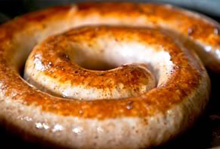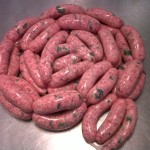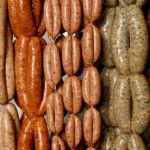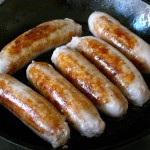What is the best sausage? In the world, I was going to ask, but since there are very different types which arguably are not comparable, I’ll confine the search to the UK – much as I love saucisson sec, chorizo, bratwurst and many many more. But to begin with, what is a sausage?
sau·sage/ˈsôsij/ Noun:
- A short cylindrical tube of minced pork, beef, or other meat encased in a skin, typically sold raw to be grilled or fried before eating.
- A cylindrical tube of minced pork, beef, or other meat seasoned and cooked or preserved, sold mainly to be eaten cold in slices.
For these purposes I will concentrate on definition 1 and bypass cooked deli sausages. The raw pork sausage beloved by the British for many generations is what I will seek, by definition excluding the revolting specimens you often find in cheap cafes and the nasty end of supermarket meat sections. These revolting beasts contain less than 50% pork but a lot of rusk, starch and other fillers alongside chemical colours and preservatives. They are encased within their skins by mass production, are limp, lifeless and have no flavour whatsoever. I urge you never to buy or eat them!
There are plenty of competitions to determine the best of the best. There is British Sausage Week, organised by the British Sausage Appreciation Society (AKA a marketing tool established by the “Red Tractor” Assured Food Standards organisation.) They do also publish facts about the sausage, which make interesting reading!
What’s In The Name?
- The word sausage derives from the Latin salsisium, meaning something that has been salted
- According to the Oxford English Dictionary, the first specific reference in English came in a fifteenthcentury vocabulary ‘Salcicia’, a ‘sawsage’
- Sausages were nicknamed bangers during the Second World War. Their high water content due to the scarcity of other ingredients meant that they were liable to explode when cooked as the water turned to steam
- Sausages should be cooked slowly over a medium heat and should not be pricked as this lets out the flavour. They will only burst if cooked too quickly!
- The British sausage even has its own Fan Club, the British Sausage Appreciation Society. The Society
- has over 5,000 members in the UK. The Highlight of the Society’s year is British Sausage Week which this year takes place from the 5th November to 11th November 2012
History of the sausage
- Sausages are even older than ancient Greece or Rome ‐ the Sumerians (modern day Iraq) made sausages 5,000 years ago
- During the early days of the Empire, Romans mixed fresh pork with finely chopped white pine nuts, cumin seed, bay leaves and black pepper
- In 320 AD, because of their association with pagan festivals, Roman Emperor Constantinus I and the Catholic Church made sausage eating a sin and their consumption was banned! This led to sausages going underground until the ban was lifted
- It is believed that sausages were brought to Britain by the Romans some time before 400 AD. Since then various English counties have each had their own way of flavoring their local sausage – e.g. Lincolnshire flavors fresh sage and Cheshire uses Caraway and Coriander
- By the Middle Ages sausage making had spread to Northern Europe and different varieties began to develop as butchers used ingredients available locally. In some locations, early sausage makers became so adept at making distinctive sausages that their fame spread across Europe
- It was in the reign of Charles I that sausages were divided into links for the first time in Britain
- Once made, sausages used to be stuck up chimneys to be mildly cured
Sausage psychology
- Delving into the mind of a sausage lover reveals that the combination of a hard exterior and soft interior and the moreish quality and succulent aftertaste makes the sausage irresistible
- Sausages evoke strong emotional ties to childhood,: memories of favourite comforting meals such as Bangers and Mash and also happy family occasions such as weekend or holiday breakfasts – special in themselves and also often because it was dad doing the cooking!
- While the convenient ease of cooking and the range of flavors from the traditional to the ethnic mean that Britons just can’t get enough
The Numbers
During the year to July 2012 we ate 196,152 tonnes of sausages, spending £707 million
This represents an increase of 3.1% compared to last year (In 2011 we ate 191,040 tons of sausages worth £667.4 million) 87% of British households buy sausages
- The Great British banger is the nation’s favorite meat‐based dinner, outselling chicken or minced beef and accounting for a staggering 864 million meals every year
- 30% of the sausage market is classified as premium, 60% as standard, 3% as low fat and 7% as economy (Volume)
- The average household buys Sausages 12.8 times per year, equal to one purchase per month
- The most popular flavor of sausage is the plain Pork sausage, which accounts for 43% of sales. Irish (17%), Cumberland (13%) takes the silver and bronze positions
- There were 864 million evening meal occasions which featured sausages.
- The peak day for Sausages to be eaten is on a Saturday, and the Sausage Sandwich has seen a 3.7% increase in meal occasions in the 12 months to Feb 2012.
- The majority of Sausages are eaten during evening meals (50%), compared with 17% Teatime, 17% Breakfast and 15% Lunch
- British shoppers are buying more branded sausages this year. Branded products have grown by 7.7% over the last 52 weeks versus 0.1% growth for retailer own label products.
Sausages today
- There are more than 470 recipes and flavors for sausages in Britain. If you take into account all the different variations from butchers across the country you could eat a different British sausage every day for ten years
- Northants butcher, Martin Trendall claims to have devised the worlds hottest sausage. Aptly named, The Pork Inferno, the sausages contain Indian Bhut Jolokia Chillies, Paprika and Chilli powder. Customers are advised to eat only one per meal!
- Sausages are an excellent source of high quality protein, containing all the essential amino acids necessary for growth, maintenance and repair of body tissue. Sausages also provide significant amounts of vitamins and minerals
- Classic Pork sausages are the nation’s favourite, with other popular varieties include Cumberland, Lincolnshire, Pork and Apple, Pork and Leek and Pork and Herb. Newer flavours gaining in popularity include Pork and Caramelised Onion and Pork and Sweet Chilli.
- Sausage preferences vary by region. The North prefers the meat more coarsely ground, whereas the South prefers sausages to be smoother
- Authentic Cumberland sausages are never split into links
- The most expensive sausage ever was made from Fillet steak with Champagne and truffles and cost £20 a pack
- Broughton‐in‐Furness pig farmer, Gary McClure, established a Guinness World Record for the world’s largest Cumberland sausage ring on the day the historic market town celebrated gaining its charter on 1 August 1575. The record‐breaking sausage measured 3.3 metres in diameter, smashing the previous record of 1.5 metres, and weighed 135 kilograms. It took six and a half hours to produce – excluding the time taken to prepare the ingredients – and 90 minutes to cook.
- Sausage machines can fill sausages at a rate of 1 1⁄2 miles an hour
- Approximately 196,152 metric tons of sausage was consumed in the UK last year! Laid end to end this gives us enough chipolatas to:
o Form a wall, four sausages high, around the entire coastline of Great Britain!
o Cover a distance from London to Perth in Australia and back twice!
o Wrap around the London Eye, the capital’s Millennium wheel, 129 thousand times!o Add another layer, 10 sausages high, to the entire length of the Great Wall of China!
Opinions abound about what constitutes a good sausage and which are the best, so here are a few for your delectation: The Guardian, The Independent, Sausagefans and many more. Lots of butchers claim to offer the Best British Sausage, including The Black Farmer, O’Hagans, Thomas’s, and Hambletons. Personally I tend to buy sausages from good butchers like Millins of Tiptree who make their own sausages and will answer questions a bout them, or shops like Procter’s in Colchester.
Make no mistake, sausages are big business in the UK. The Newmarket Sausage even recently won protected status, though you might equally have said the same about other variants associated with geographical areas (Cumberland sausages, best sourced in Carlisle, for example.)
So what do you look for in a good sausage? Firstly, whatever flavourings or seasonings are used, the quality of the pork is paramount. The best will have genuinely free-range pork sourced from a traditional breed, slow-grown, outdoor-reared and well fed. You really can taste the difference, not least because these pigs will build up a bigger layer of fat, which in sausages is critically important for the next stage.
When you make sausages, the balance is between lean cuts pork and fatty cuts like belly. Fat offers succulence and flavour, so finding the right balance makes the difference between a moreish banger and one that tastes dry and unappealing. The overall proportion of pork is also vital. Rusk will mop up fat but more rusk means less flavour. The best will have a truly porky flavour, for which, in my humble opinion, not less than 80% meat is critical. You could put in 100% pork but having clear liquid oozing from your snags is not terribly appetising. A little binding ingredient and the ability to absorb some fat works better, so the optimum would be in the region of 90-95%.
How coarse or smooth your pork depends on the recipe. Cumberland sausages, traditionally sold in long spiralled rings rather than links, use coarsely minced pork with flavourings including black pepper. Personally I prefer some texture and a stronger taste of pork, so coarser suits me fine. Finer mincing works best for your breakfast snags, especially if you intend to slice them vertically to go in a sausage sarnie.
Next there are the skins. Traditional natural sausage skins are made from a layer of the intestinal tract, preferably of pigs. Most sausages use artificial skins made from collagens taken from cattle, though other artificial products are used to make skins (don’t ask!) As Wikipedia correctly states, “Natural casings breathe, allowing smoking and cooking flavors to permeate the casing and infuse the meat, giving the sausage a rich, even flavor throughout. Natural casings have unique natural curves and sheen, with rounded ends where the sausage is linked giving the sausage visual appeal.” You can choose traditional thick sausages, but chipolatas, traditionally served with your Christmas turkey, are great for breakfast where you want them cooked in a hurry.
What flavourings are best depends on your personal preference, though typical varieties in common circulation these days include various herbs and spices, apple, onion, garlic, even chilli! This is Procter’s list of sausage varieties:
Old English Breakfast | our biggest prize winner and a great way to start the day
Pork Chipolata | a real winner with the younger folk, or if you’re just in a hurry
Cumberland | a fine traditional recipe loaded with coarse black pepper
Lincoln | a regional favourite for lovers of sage
Suffolk Orchard | a mild sausage sweetened with cider and apples
Suffolk Pride | coarse cut lean pork with black pepper and sage
Norfolk Herb | flavoured with field grown Norfolk herbs
Essex | distinctive ginger and mace flavours
Pork and Leek | a full savoury flavour, great in Toad-in-the-Hole
Hog and Hop | bangers and beer, a dream come true!
Garlic and Parsley | more than just a hint for this romance killer
Pork and Stilton | a real English flavour, try with bubble and squeak
Lemon and Ginger | hmm, aromatic and spicy all in one sausage
Pork and Tomato | finished with sage and ginger, it’s just too scrummy
The Stout Porker | pork and Guinness, eat too many and you’ll become one
Chilli Hot Cajun | a fiery sausage not for the faint hearted but a BBQ favourite
…and really meaty! Still coarse ground pork but with a more continental texture. Try from the following
Cambridge | coarse black pepper and a light touch of herbs
Farmhouse Country Pork | Provence herbs give this a unique character
Chorizo | this Spanish recipe is picante i.e. spicy
Bratwurst | our version of the German classic is based on a recipe from the region of Thuringer, with a slightly smoky flavour
Toulouse | Ideal for winter warming cassoulet, a coarse pork sausage with garlic, parsley and red wine
Italian | inspired by Sicilian recipes, with fennel, peppers and white wine
Luganega | north Italian recipe with Parmesan, garlic, coriander, lemon and vermouth
Beef and Guinness | rich, meaty, succulent – an absolute classic
Beef and Horseradish | almost good enough to replace the Sunday roast
Beef, Wild Mushroom and Tomato | a combination of earthy flavours and rich succulence with a peppery finish
Lamb and Mint | shoulder of lamb loaded with mint – another candidate for best Toad-in-the-Hole sausage
Lamb Basil and Tomato | gluten free, an all meat recipe bursting with aromatic flavour
Mediterranean Lamb | gluten free, all meat with lemon, garlic and parsley
Merguez | gluten free recipe from Algeria, lamb and beef combining with hot and spicy harissa
Chicken Lemon and Coriander | gluten free, delicious aromatic sausage
Chicken and Wild Mushroom | gluten free, with rich earthy flavours
Chicken Kiev | gluten free, garlic butter melts into the slowly sizzling sausage
Sweet Chilli Chicken | gluten free, not too hot, it just leaves a warm glow
Chicken Peri Peri | gluten free, again lightly spicy rather than chilli hot
Gressingham Duck and Orange | moist, succulent, indulgent sausage
Aromatic Gressingham Duck | with five spice, hoi sin and soy sauce
Whilst our wild boar is farmed, all our venison is wild from Forestry Commission sustainably managed woodlands
Venison with Forest Fruits | fruits sourced from local fruit farms, a favourite for casserole recipes
Venison and Spiced Juniper | a great winter warmer, pop in a hotpot with dumplings
Wild Boar with Apple and Cinnamon | gamey meat with fruit is a classic combo
Wild Boar with Forest Fruits | finished with sage, this is a rich and hearty sausage
Apart from the vegetarian community (and don’t get me on to veggie sausages), there is something there for everyone! Cook, eat and enjoy! Oh, and my ultimate sausage remains those Cumberland sausages bought in Carlisle – but I would love to sample the contenders to choose my favourites!










